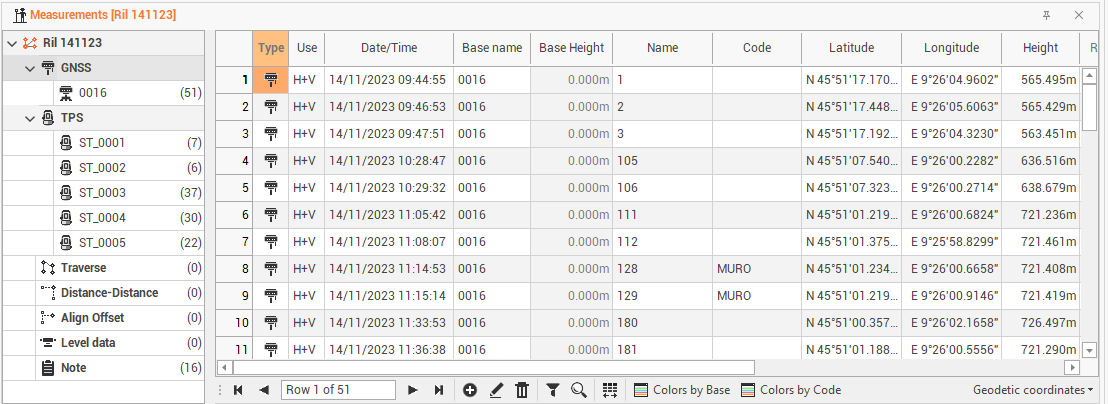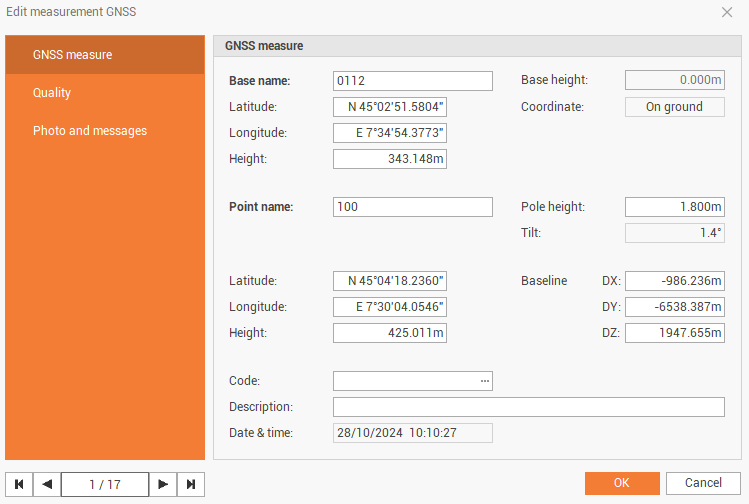GNSS measurements
The GNSS measurements are listed in the Measurements table under GNSS. They are grouped by base name.
GNSS measurements table
The table contains information on GNSS measurements, grouped by base name.

The information available are the following:
Type: indicates whether the point is a base or a point measured in rover mode.
Use: to set the mode in which the program uses the measurement in the calculation of the survey. The option H + V allows the program to use both the horizontal and vertical component of the measurement. The option Only H or Only V They set the use of the measure only as a horizontal measure or only as a vertical one.
Base name: the name of the GNSS base.
Base height: the height of the base.
Name: the name of the point.
Code: the survey code associated with the measured point.
Longitude: the point longitude.
Latitude: the point latitude.
Height: the ellipsoidal height.
Rover height: the height of the rover antenna.
Description: the point description.
Date/time: the date and time when the point was measured.
Recording: this box shows if there are voice notes related to the measurement.
Image/sketch: this box shows if there is an image associated with the measure.
Delta X/Y/Z: the delta of the baseline vector.
Epoch: how many epochs was used to measure the point.
GDOP/HDOP/PDOP/VDOP: the DOP (diluition of precision) values for the measure.
GPS/Glonass/Beidou/Galileo: the number of satellites used for the measure.
Solution: the solution type of the measure (RTK fixed, RTK float, autonomous).
Tilt: if an IMU receiver is used, this field shows the tilt of the pole when measurement was done.
HRMS: horizontal precision.
VRMS: vertical precision.
XX/XY/XZ/YY/YZ/ZZ: values of the variance/covariance matrix.
Can change the display layout of the table from the bottom right button, which allows you to view other data related to GPS measurements.

The following options are available:
Baseline: to enable the display of baseline data (Delta X, Delta Y, Delta Z).
Covariance: to enable the display of data in the variance/covariance matrix, this data cannot be modified.
Geodetic coordinates: to enable the display of data of longitude, latitude and ellipsoidal height.
DOP: to enable the display of data on the accuracy of the GNSS measure (HDOP, VDOP, GDOP, PDOP).
Quality: to enable the display of measurement quality data (solution, HRMS, VRMS, Epochs, Tilt).
Save Layouts as default: to save table layout as default. It means that the settings applied to the layout (position of columns, display of columns etc...) will be applied as default to open tables later.
Restore default Layouts: to allow to undo the changes applied to the table layouts and restore the standard display.
If there are multiple bases, you can view the measurements of each base by expanding the tree node.
The bottom toolbar of the table presents the following commands in addition to the basic commands:

Colors by base: to set a color to the baselines according to the base name.
Colors by code: to set a color to the baslines according to the survey code.
Edit GNSS measurements
Double-click on a measure or click on Edit to access a specific window that allows the measurement data changing also displaying the measurement quality data (Epochs, Solutions, DOP, covariance factors, etc.).
The GNSS measure page shows information on the GNSS measured coordinate and baseline

Base name: the name of the GNSS base.
Base height: the height of the base.
Longitude: the base longitude.
Latitude: the base latitude.
Height: the base ellipsoidal height.
Point name: the name of the point.
Pole height: the height of the rover antenna.
Tilt: if measure has been done with an IMU receiver, this field shows the tilt of the pole.
Longitude: the point longitude.
Latitude: the points latitude.
Height: the points ellipsoidal height.
Baseline DX/DY/DZ: the delta of the baseline vector.
Code: the survey code associated with the measured point.
Description: the point description.
Date/time: the date and time when the point was measured.
The Quality page shows information on the quality of selected GNSS measure.

Solution: the solution type of the measure (RTK fixed, RTK float, autonomous).
HRMS: horizontal precision.
VRMS: vertical precision.
Epoch: how many epochs was used to measure the point.
GDOP/HDOP/PDOP/VDOP: the DOP (diluition of precision) values for the measure.
GPS/Glonass/Beidou/Galileo/SBAS: the number of satellites used for the measure.
XX/XY/XZ/YY/YZ/ZZ: values of the variance/covariance matrix.
The Photo and messages page shows the photo and vocal message assigned to the point.

